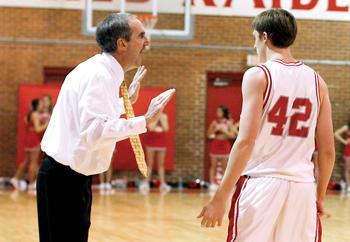Attention getters
Coaches have distinct communication styles
Friday, February 11, 2011
The old saying is to "Whistle While You Work."
Baylor boys' basketball coach Austin Clark can't whistle, but as a coach he must work, so he must resort to other ways of getting the attention of his players during games.
For the past 29 seasons, Clark's method of getting his players to tune in or catch signals has been to stomp the floor. It's considered his way, but coaches find themselves getting into the game and trying to relate with the players however they can.
"I wish I knew how to whistle," Clark said, noting he has to resole shoes every offseason. "It would be better for me and probably less stress on my feet."
Clark's stomping is meant to get the attention of the players; therefore, he has to wear a shoe that can be heard. So no rubber soles.
"I tried it once, but the sound was muffled and they couldn't hear me," Clark said. "I have to wear regular street shoes because the bottom slaps the wood well."
Whether stomping feet, waving, yelling, screaming, using "White Boards" or in the case of former Riverside and Memphis Melrose coach Dorsey Sims, waving a red bandana -- coaches must be able to communicate with their players on the floor. All have their specific mannerisms.
Some are superstitious, while others get lost in the game itself.
Sometimes when yelling, Bradley Central coach Kent Smith puts his hands behind his back. Howard coach Walter McGary can sometimes be seen with what could be perceived as a disgusted look on his face, even after a good play by one of his Hustlin' Tigers.
McMinn Central girls' coach Johnny Morgan sometimes has a disinterested look while his second-ranked Chargerettes are in action. All coaches agree that the mannerisms that define who they are reflect their personalities.
For example, longtime Martin Luther King coach James "Doc" Shelton could be seen doing any variety of things during a game, from having straw in his mouth to loosening his tie and unbuttoning his shirt, to jumping on a scorer's table, to calling a timeout and taking his team into the stands for a huddle.
Tyner's Gerald Harris, who was given his first coaching opportunity by Shelton, said he doesn't really have a style or standout in-game trait but does try to do whatever is needed to get on the same page as his players.
"I look at it from a perspective that there shouldn't just be one way to coach," he said. "I think that it becomes a matter of the team, the personnel and being able to understand what motivates kids. Some respond to yelling; others don't.
"I just try to get their attention when needed and motivate when I have to."
Clark and Harris both noted that, like players, coaches can get into a zone to where they don't notice what the opposing coach is doing.
"I never deal with that," Harris said. "It's not important to me; I'm trying to be in tune with those I am coaching.
"I might glance in his direction during a timeout, to check his demeanor. If he's getting onto his players, I'll tell my players to play even harder, dig deeper, because his team is going to be stressed coming out of the timeout."
Said Clark: "During the game, my adrenaline is flowing. I'm with them on every play; I don't get to play anymore, so I get into the game.
"Every coach has a way to get in touch with his kids. I get into the games, because when I stop getting into it, I need to quit coaching. The day I'm not into the game is the day I need to get into something else because the passion is gone."
Follow Gene Henley on Twitter by following this link.

